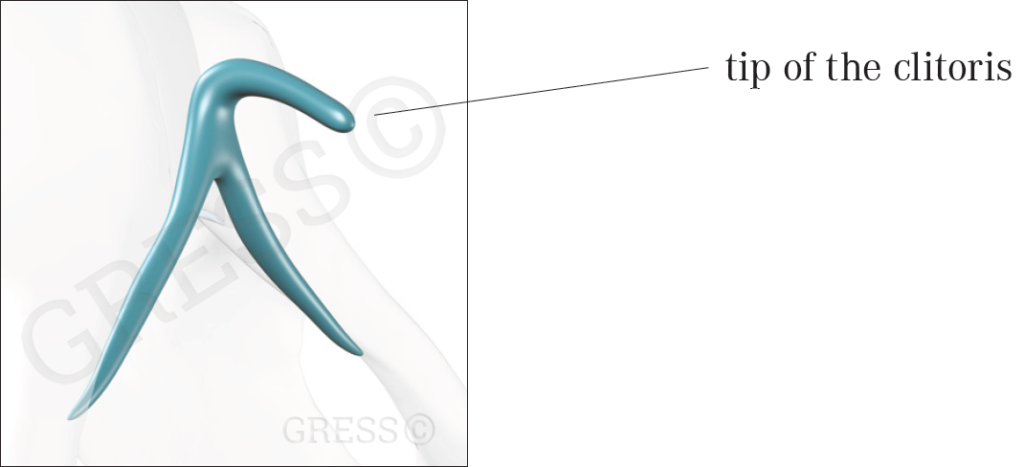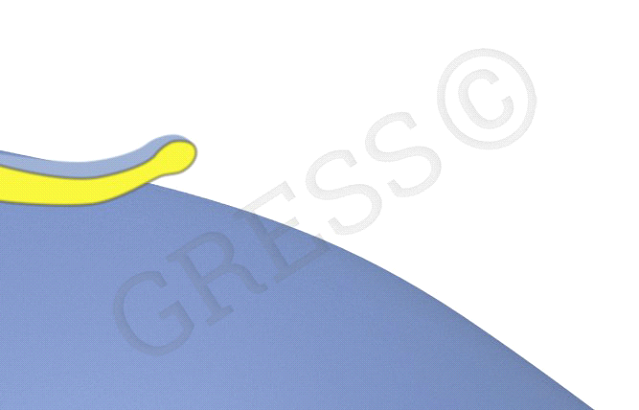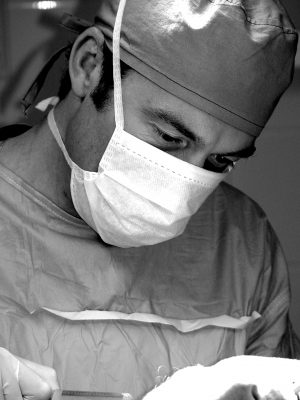
Prof. asoc. Dr. Stefan Gress
Plastic & Aesthetic Surgeon






Correction of the clitoris and clitoral hood
Professor Gress is one of the
top specialists internationally
What would you like to find out more about?
Correction of the clitoris and clitoral hood
All important information
The clitoris means “small hill”. It is the only organ that serves solely for sexual stimulation.
A true enlargement of the clitoris (clitoral hypertrophy) is very rare and is often mistaken for an enlargement of the clitoral hood (hypertrophy of the prepuce) or a visible protrusion of the clitoris (clitoral protrusion).
Prof. Gress was the first to develop and publish surgical correction procedures for these anatomical changes. Today, these procedures are the worldwide standard…
Anatomy
The clitoris is shaped like a three-dimensional, inverted Y, with both shanks resting on the pubic bone. The fusion of the two shanks creates the clitoris shaft, which also pulls down largely in the recess above the middle of the pubic bone. Only the tip of this shaft is the part that is visible from the outside.
This clitoris tip corresponds anatomically to the glans of the penis and is the shape and size of a berry. In general terms, when one refers to the “clitoris”, anatomically speaking, this is merely the tip of the clitoris.
Anomalies in size and shape can be caused by hormonal influences during embryonic development in particular.

Clitoris consisting of two shanks and a central shaft. The tip of the shaft is the only visible part of the clitoris and is commonly referred to as the “clitoris”.
Following is information regarding correcting a:
⦁ Clitoral protrusion
⦁ Reduction of the clitoral hood
⦁ Correction of a true clitoral enlargement
Video – Procedure

1. Clitoral protrusion
The inner labia (minora) and the clitoris are anatomically completely different structures. Anatomically, however, they are closely connected in that the labia minora closely surround the clitoris on both sides.
If the labia minora are very pronounced and very long, there is often also a protruding clitoral tip. This is often difficult to determine at first glance, as the tip of the clitoris is covered by the long labia and the large clitoral hood.
If the clitoral hood is then tightened and the labia shortened during the labia reduction procedure, a protruding clitoris can be more noticeable than before, as it has reduced coverage by the labia minora.
It is therefore aesthetically and functionally useful to correct the protruding clitoris, especially if you want the outer labia to completely cover the inner labia.


How does it work?
A protruding clitoral tip can’t simply be pushed in, but it is possible to lower it downwards. This is done simply by removing a segment of skin below the clitoris and releasing the lower clitoral anchor. By joining the edges of the wound, the clitoris is then lowered in both the lateral and frontal plane:

Since the clitoris itself is not touched in this technique, there is no danger of reduced sensitivity. On the contrary: In about 40% of cases, sexual intercourse results in improved stimulation. This is due to the fact that the clitoris is situated a little closer to the vaginal entrance and can be stimulated more directly.
The corrective positioning of the clitoris is now an integral part of a comprehensive labia reduction procedure. For more details, see composite reduction labiaplasty
2. Reduction of the clitoral hood
The part of the labia minora that surrounds the clitoris is called the clitoral hood. In fact, the clitoral hood is not a separate anatomical structure but part of the inner labia.
It varies greatly in appearance from woman to woman. It can be very voluminous and completely cover the clitoris tip and hang over it like a curtain, or it can be small and firm and partially or completely expose the clitoris tip.
Most patients want a taut clitoral hood that covers the clitoral tip entirely or almost entirely. A completely exposed clitoral tip does not imply reduced ability for sexual stimulation (after all, the glans of the penis is also uncovered in circumcised men), but for many women, it is aesthetically more pleasing if the clitoris is covered.
3. Correction of a true clitoral enlargement
In rare cases, the clitoris itself may actually be enlarged. Usually, the entire clitoris is enlarged and not just the tip. This is caused by hormonal disorders, especially in the embryonic development phase, or masculinization, especially resulting from the intake of hormones, such as anabolic steroids, by bodybuilders. Intersexual syndromes can also be present, which are also the result of a hormonal imbalance. As the first step, it is essential to clarify the cause through a comprehensive hormonal analysis.
The clitoral hood is always tightened as part of the techniques for labia reduction described here, with one exception. The technique of “composite reduction labiaplasty” provides a particularly effective tightening of the clitoral hood, since, in addition to correcting the clitoral protrusion, the procedure simultaneously tightens the clitoral hood both upwards and downwards.
There are many procedures for sex correction, especially in intersexual syndromes, which we will not go into here in detail.
During the reduction of an enlarged clitoral tip, a wedge is removed from the lower edge of the clitoral tip. By joining the wound edges, the clitoral tip is then reduced by the wedge-shaped portion that was removed. Sensory disturbances are not to be expected, as the nerves transmit sensation to the clitoral tip from above and the segment is removed at the bottom.
Prof. Gress has published most of his medical publications with Springer Verlag.
His textbook on correcting the outer female genital region entitled „Aesthetic and Functional Labiaplasty“ was published in 2018.
This book describes his techniques for reducing the labia minora, primarily the “composite reduction labiaplasty”, and techniques for correcting the labia majora and the mons pubis. This textbook is now the standard for colleagues in this field throughout the world.
Publications by Prof. Gress:
(click for further information)
Good to know
Useful information
Does the clitoris remain covered?
Normally, the clitoral hood provides the same coverage for the clitoris as before the procedure. This is a frequently asked question, the concern being that the clitoris might lose sensitivity due to the reduced coverage. Although this is not the case, we make sure that coverage of the clitoris is not changed in order to maintain the familiar situation.
Are there any sensory disturbances to be concerned about?
The clitoris is not touched, let alone the relevant nerves, either during correction of a clitoral protrusion or during the tightening of the clitoral hood. Therefore, if the procedure is properly performed, there is no reason to be concerned about reduced ability for sexual stimulation of the clitoris. As a rule, the sensation will remain the same as it was before the operation. In some cases (approx. 38%) sexual stimulation is even slightly increased after the position of a protruding clitoris is corrected (as in a composite reduction labiaplasty), since the clitoris is moved a little closer to the vaginal entrance, which enables more direct stimulation during sexual intercourse.
Even with reduction of a true clitoral enlargement (clitoral hyperplasia), sensory disturbances are not to be expected, since the nerves transmit sensation to the clitoris from above, while the segment removed to reduce the clitoris is taken from the below the clitoral tip.
Can a clitoral correction be performed even without reduction of the labia minora?
It can be done, of course, but the tightening of a greatly enlarged or possibly even sagging clitoris hood is always part of a correction of enlarged inner labia, so that a clitoris correction is usually performed in connection with a labia reduction. On the other hand, reduction of the clitoris tip in cases of true clitoral hyperplasia without labia correction is very well possible.
Is it possible to correct the position of the clitoris simply to increase stimulation?
Positioning the clitoris downward towards the vaginal entrance for stimulation purposes alone is not advisable, since the probability of achieving improved stimulation is quite low at 38%.
For more information on preparation and aftercare, please see: Labia reduction

Best Results
by specially developed, internationally leading surgical technique “Composite Reduction Labiaplasty”

Greatest Experience
With the most operations in
the female genital
area worldwide

Media Partner
First point of contact for international media for all questions relating to intimate surgery
Prof. Dr. Gress
Experience makes the difference
- More than 6700 procedures in the female genital area
- Over 20 years of experience
- Inventor and developer of the “Composite Reduction Labiaplasty”
- Internationally recognized top specialist
- Author of the international textbook “Aesthetic and Functional Labiaplasty” (Springer Publishers)
- Professor and Lecturer in Plastic Surgery


„Pioneer of female genital surgery“

„The Vagina Picasso“

„The labia pope of Germany“

Memberships
In the most important national and international specialist societies

American Society of Plastic Surgeons

Deutsche Gesellschaft der Plastischen, Rekonstruktiven und Ästhetischen Chirurgen

International Confederation for Plastic, Reconstructive and Aesthetic Surgery

International Society of Aesthetic Plastic Surgery

The Aston Baker
Cutting Edge
Aesthetic Surgery
Symposium
2018, New York
Faculty Member
The greatest honor for
a Plastic Surgeon
Aesthetic and Functional Labiaplasty
The internatioanl Textbook
written by Prof. Gress

Published in January 2018 by Springer Verlag, it has developed into an international bestseller and standard work in plastic surgery.
















